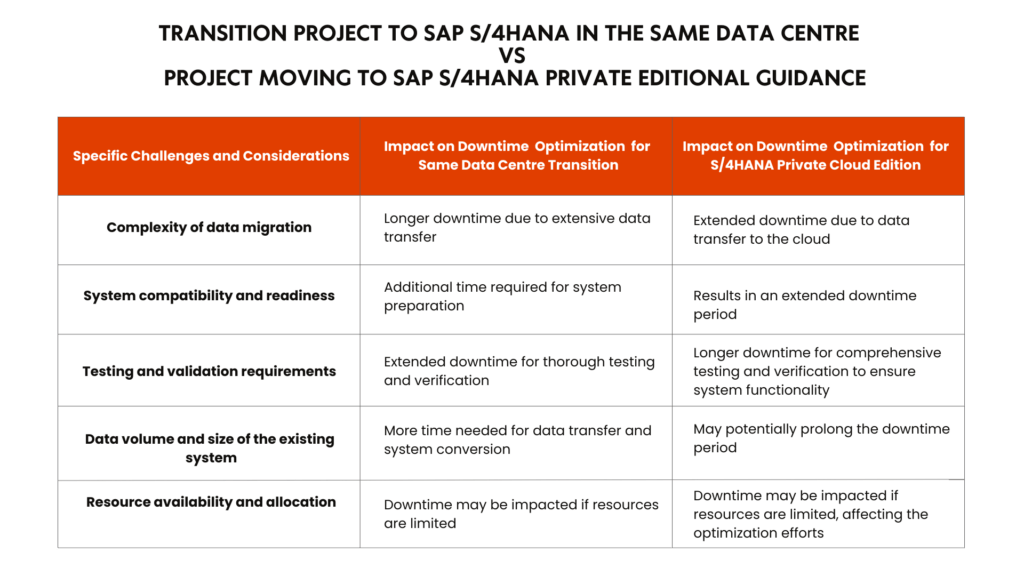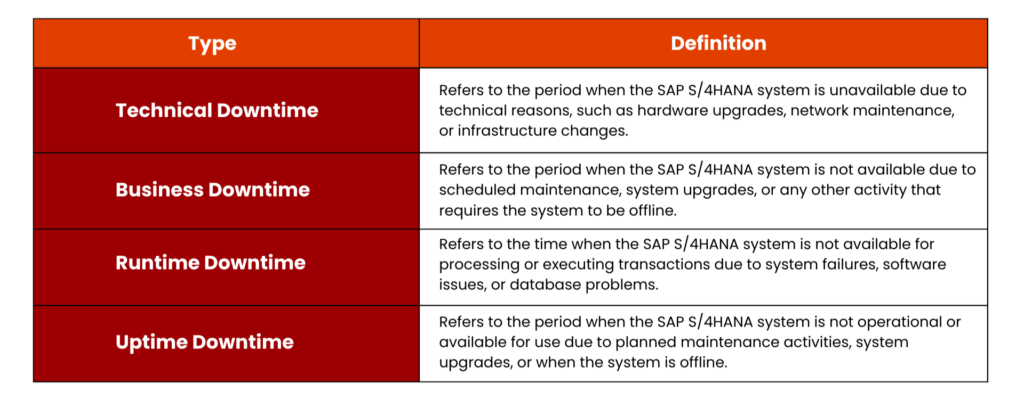Hey Folks!
So You’re Thinking About Upgrading to SAP S/4HANA?
Doing More with Less: We all know how important Downtime Optimized Conversion is, but are we really making the most of this time?
In the realm of business, time is a currency, and downtime is an opportunity. It’s a chance to do more with less, to harness the untapped potential that lies within those seemingly idle moments.
Yet, all too often, these windows of opportunity slip through our fingers, leaving us wondering if we’ve truly maximized our progress during the transition.
However, transitioning to SAP S/4HANA is not a trivial task. It requires careful planning, diligent execution, and, most importantly, optimized utilization of downtime during the transition processes. Downtime optimization presents a unique opportunity for businesses to maximize their efficiency and ensure uninterrupted progress throughout the upgrade journey.
Join us as we uncover the untapped potential of downtime optimization and learn how you can enhance the efficiency and effectiveness of your SAP S/4HANA transition processes.
Let’s dig into what downtime optimization means, why it matters, and how it could be hurting your business.
What Is Downtime Optimization?
Downtime optimization refers to the process of minimizing the amount of time a system is unavailable during maintenance, upgrading, or migration. Its primary objective is to minimize disruptions to business operations. By effectively managing downtime, organizations can mitigate the negative consequences such as decreased productivity, revenue loss, customer dissatisfaction, and potential damage to their reputation.
Importance of Downtime Optimized Conversion Considerations
Optimizing downtime during system transitions is crucial for ensuring smooth business operations. Here are some factors that need to be considered for effective downtime optimization:
Plan ahead: It is essential to plan ahead and schedule downtime during off-peak hours to minimize the impact on business operations.
Prioritize critical operations: Identify critical business operations that need to be maintained during the transition period and prioritize them accordingly.
Test the new system: Before the transition, test the new system thoroughly to ensure that it is functioning correctly and can handle the workload.
Backup data: Ensure that all critical data is backed up before the transition to prevent data loss.
Communicate with stakeholders: Communicate with stakeholders about the downtime schedule and the expected impact on business operations.
Monitor progress: Continuously monitor the progress of the transition to identify any issues and take corrective actions promptly.
Implementing these downtime optimization considerations can help businesses minimize the impact of system transitions and ensure smooth operations.
Downtime Duration Differences:
Certainly! Here’s a list of the types of downtime in SAP S/4HANA, along with their definitions.
In SAP S/4HANA, downtime refers to the period during which the system is not available for use or maintenance. The types of downtime in SAP S/4HANA can be categorized as follows:
Different types of Downtime in SAP S/4HANA
Let’s delve into the approaches that can significantly reduce downtime and optimize SAP S/4HANA performance.
Approaches for Downtime Reduction and Performance Optimization in SAP S/4HANA
For conversion projects, a downtime reduction strategy or plan is crucial, since less downtime will result in maximum advantages for the businesses. Downtime optimisation significantly reduces downtime for conversion projects.
SAP offers the following four approaches that can significantly reduce downtime during SAP S/4HANA migrations:
Approach 1: Near Zero Downtime Maintenance (nZDM)
nZDM is a methodology introduced by SAP to minimize downtime during system conversions or upgrades. It replicates and synchronizes data between the source and target systems, resulting in minimal downtime while the upgrade process is ongoing.
Approach 2: Database Migration Option (DMO) with System Move (DO-DMO)
DMO with System Move (DO-DMO) is an approach that combines system conversion and database migration into a single step. This technique performs a homogeneous system conversion and database migration simultaneously, reducing downtime.
Approach 3: Database Migration Option (DMO)
DMO is a proven approach for migrating to SAP S/4HANA, providing businesses with a streamlined migration process. By performing the conversion directly within the existing database DMO enables organizations to convert their existing SAP ERP system to SAP S/4HANA while preserving data integrity and minimizing downtime.
Approach 4: New Zero Downtime Technology (NZDT)
NZDT is a relatively new approach that leverages innovative technology to reduce downtime during system upgrades. It introduces an additional server to synchronize the source and target systems significantly minimizes downtime by utilizing intelligent algorithms and data compression techniques.
By leveraging these downtime reduction techniques, businesses can minimize disruption, optimize resources, and unlock the full potential of SAP S/4HANA.
Best practices for Downtime Optimization
Here are five best practices for maximizing operational efficiency in SAP S/4HANA:
- Schedule downtime during low activity periods to minimize disruption and coordinate with stakeholders.
- Conduct comprehensive system assessments to identify bottlenecks and optimize performance, reducing the need for downtime.
- Employ robust monitoring tools and regular maintenance activities to detect and address issues before they escalate.
- Utilize virtualization technologies and high availability solutions for seamless failover and uninterrupted access during maintenance.
- Set up testing environments to validate changes, reducing the risk of errors and ensuring smoother deployments.
Following these practices will enhance system availability and efficiency, reducing downtime in SAP S/4HANA.
Tools and Techniques for Downtime Optimization
There are multiple tools and techniques that can be used for downtime optimization, including:
- SAP DMO with System Move
- SAP Landscape Transformation (SLT) replication server
- SAP HANA System Replication
- SAP HANA System Replication with Storage Replication
Conclusion
In conclusion, by harnessing the potential of downtime, organizations can not only minimize disruptions but also drive continuous improvement, reduce costs, and accelerate their journey towards SAP S/4HANA. To ensure business continuity, an effective plan must be cultivated to minimize downtime. Various tools, techniques, and vendor services are available to achieve this. By leveraging best practices and new technologies, you can minimize downtime and ensure project success.
KaarTech, with its 17+ years of expertise in SAP services and solutions, including successful implementation of 70+ SAP S/4HANA Projects, is well-equipped to assist you in optimizing downtime. Contact us for more information on downtime optimization and how we can help your organization develop effective plans for system maintenance, upgrading, and migration.
FAQ’s
What is Downtime Optimization?
Downtime optimization refers to the process of minimizing the amount of time a system is unavailable during maintenance, upgrading, or migration. It is essential to ensure that the impact of the downtime on the business operations is minimized.
What are the key principles and concepts of Downtime Optimization?
Key principles and concepts in downtime optimization include proactive maintenance, predictive analytics, efficient scheduling and resource allocation. By implementing these principles, organizations can maximize productivity, reduce costs, enhance reliability, and improve overall operational efficiency.
List the Tools and Techniques for Downtime Optimization
Several tools and techniques can be used for downtime optimization, including:
• SAP DMO with System Move
• SAP Landscape Transformation (SLT) replication server
• SAP HANA System Replication
• SAP HANA System Replication with Storage Replication
What the approaches for SAP S/4HANA Downtime Reduction?
SAP offers the following four approaches that can significantly reduce downtime during SAP S/4HANA migrations namely:
• Near Zero Downtime Maintenance (nZDM)
• Database Migration Option (DMO) with System Move (DO-DMO)
• Database Migration Option (DMO)
• New Zero Downtime Technology (NZDT)


